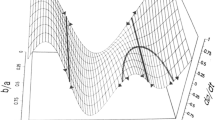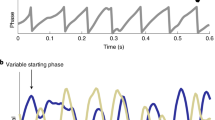Abstract
The paper argues that cognitive states of biological systems are inherently temporal. Three adequacy conditions for neuronal models of representation are vindicated: the compositionality of meaning, the compositionality of content, and the co-variation with content. Classicist and connectionist approaches are discussed and rejected. Based on recent neurobiological data, oscillatory networks are introduced as a third alternative. A mathematical description in a Hilbert space framework is developed. The states of this structure can be regarded as conceptual representations satisfying the three conditions.
Similar content being viewed by others
References
J. Fodor (1992) A Theory of Content and Other Essays MIT Press Cambridge MA
J. Fodor E. Lepore (2002) The Compositionality Papers Oxford University Press Oxford
J. Fodor Z. Pylyshyn (1988) ArticleTitle‘Connectionism and Cognitive Architecture: A Critical Analysis’ Cognition 28 3–71 Occurrence Handle10.1016/0010-0277(88)90031-5
K. Gödel (1932) ArticleTitle‘Zum intuitionistischen Aussagenkalkü’ Anzeiger Akademie der issenschaften Wien 69 65–66
S. Gottwald (2001) A Treatise on Many-Valued Logics Research Studies Press Baldock
Gray C. M. and W. Singer: 1989, ‘Stimulus-Specific Neuronal Oscillations in Orientation Columns of Cat Visual Cortex’, Proceedings of the National Academy of Sciences, USA. 86, 1698–1702.
W. Hodges (2001) ArticleTitle‘Formal Features of Compositionality’. Journal of Logic, Language and formation 10 7–28
T. Horgan J. Tienson (1996) Connectionism and the Philosophy of Psychology MIT Press Cambridge MA
D. H. Hubel T. N. Wiesel (1962) ArticleTitle‘Receptive Fields, Binocular Interaction and Functional Architecture in the Cat’s Visual Cortex’ Journal of Physiology 160 106–154
T. Janssen (1997) ‘Compositionality’ J. Benthem Particlevan A. terMeulen (Eds) Handbook of Logic and Language Elsevier Amsterdam 417–473
J. Kim (1993) Mechanism, Purpose and Explanatory Exclusion Cambridge University Press ambridge, MA
A. Maye (2002) ‘ Neuronale Synchronität, zeitliche Bindung und Wahrnehmung’ TU Berlin Berlin
T. B. Schillen P. König (1994) ArticleTitle‘Binding by Temporal Structure in Multiple Feature Domains of an Oscillatory Neuronal Network’ Biological Cybernetics 70 397–405
W. Singer C. M. Gray (1995) ArticleTitle‘Visual Feature Integration and the Temporal Correlation Hypothesis’ Annual Review of Neuroscience 18 555–586 Occurrence Handle10.1146/annurev.ne.18.030195.003011
P. Smolensky (1995) ‘Connectionism, Constituency and the Language of Thought’ C. Macdonald G. Macdonald (Eds) Connectionism Blackwell Cambridge, MA 164–198
W. Spohn (1988) ‘Ordinal Conditional Functions’ W. Harper B. Skyrms (Eds) Causation in Decision, Belief Change, and Statistics Reidel Dordrecht 105–134
M. Werning (2001) ‘How to Solve the Problem of Compositionality by Oscillatory Networks’ J. D. Moore K. Stenning (Eds) Proceedings of the Twenty-Third Annual Conference of the Cognitive Science Society Lawrence Erlbaum Associates London 1094–1099
Author information
Authors and Affiliations
Corresponding author
Rights and permissions
About this article
Cite this article
Werning, M. The Temporal Dimension of Thought. Synthese 146, 203–224 (2005). https://doi.org/10.1007/s11229-005-9089-2
Issue Date:
DOI: https://doi.org/10.1007/s11229-005-9089-2




